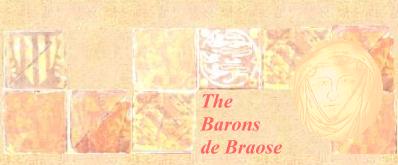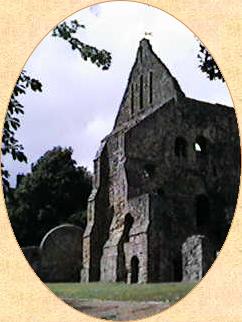
Introduction

The Barons de Braose were
a formidable force in medieval England and Wales. Their origins
were in Briouze, Normandy and after 1066 the family settled in
the Adur Valley of West Sussex, England. In Wales the spirit
of conquest sustained them for 250 years. The terror of their
reputation had few equals although they were themselves overwhelmed
by injustice and tragedy several times.
Strangely, the name de
Braose receives little attention in history books today. It isn't
easy for local people to identify and appreciate their medieval
heritage. Many families across the world have discovered a personal
link with the Braoses through their genealogy. This remarkable
ancestry has often been difficult to trace with accuracy. Our
history of the Braoses has been pieced together from the charters,
chronicles and other documents which have survived the centuries,
and the later work of historians. There is still a great deal
more to discover and to understand.
The story of the Braoses
is also written in the stones of churches and castles. Some of
the most beautiful sites of Britain's medieval heritage are associated
with the Braose family. Their traces can be seen in Normandy
and Ireland too. Whatever your interest, we hope you enjoy this
web site and can visit some of the marvellous places that illustrate
the history of the Barons de Braose.
Please write if you have
any views or information to add. We have many more details on
file which may help your own research and we are always happy
to discuss our work. Denise Roussel is our web-partner in Normandy
and thanks to her we are able to maintain this site in French
as well as English.
The
Beginning
 The
Battle of Hastings on October 14, 1066 marked a turning point
in the history of England. William Duke of Normandy invaded the
country with seven thousand men, including over two thousand
mounted knights and squires.
The
Battle of Hastings on October 14, 1066 marked a turning point
in the history of England. William Duke of Normandy invaded the
country with seven thousand men, including over two thousand
mounted knights and squires.
William's army landed at
Pevensey and established a stronghold at the town of Hastings.
King Harold of England was far away in York, having recently
defeated his brother Tostig and Harold Hardrada of Norway at
the battle of Stamford Bridge. King Harold marched rapidly south
and met the Norman invaders at the hill of Senlac.
King
Harold's army fought on foot but made a challenging opposition
until, crowded on top of the hill, they were overcome by volleys
of Norman arrows and cavalry charges. The slaughter was immense.
William the Conqueror went on to enforce his rule with brutal
efficiency. He was crowned at Westminster Abbey on Christmas
Day.
The Normans were energetic
warriors but also deeply religious. The altar of Battle Abbey was placed on the spot where King
Harold was wounded with an arrow and cut down. Norman fighting
men were obliged to do heavy penance for the sins of war. William
the Conqueror founded the Benedictine abbey in 1070 for the salvation
of his soul.
Many Norman lords who sailed
to England with Duke William contributed some of their new found
wealth to the abbey. Among these "Companions of the Conqueror"
was William de Braose. (1.1)

back
to text
The Barons de Braose were a formidable force in medieval England and Wales. Their origins were in Briouze, Normandy and after 1066 the family settled in the Adur Valley of West Sussex, England. In Wales the spirit of conquest sustained them for 250 years. The terror of their reputation had few equals although they were themselves overwhelmed by injustice and tragedy several times. Strangely, the name de Braose receives little attention in history books today. It isn't easy for local people to identify and appreciate their medieval heritage. Many families across the world have discovered a personal link with the Braoses through their genealogy. This remarkable ancestry has often been difficult to trace with accuracy. Our history of the Braoses has been pieced together from the charters, chronicles and other documents which have survived the centuries, and the later work of historians. There is still a great deal more to discover and to understand. The story of the Braoses is also written in the stones of churches and castles. Some of the most beautiful sites of Britain's medieval heritage are associated with the Braose family. Their traces can be seen in Normandy and Ireland too. Whatever your interest, we hope you enjoy this web site and can visit some of the marvellous places that illustrate the history of the Barons de Braose. Please write if you have
any views or information to add. We have many more details on
file which may help your own research and we are always happy
to discuss our work. Denise Roussel is our web-partner in Normandy
and thanks to her we are able to maintain this site in French
as well as English. The
Beginning
William's army landed at Pevensey and established a stronghold at the town of Hastings. King Harold of England was far away in York, having recently defeated his brother Tostig and Harold Hardrada of Norway at the battle of Stamford Bridge. King Harold marched rapidly south and met the Norman invaders at the hill of Senlac. King Harold's army fought on foot but made a challenging opposition until, crowded on top of the hill, they were overcome by volleys of Norman arrows and cavalry charges. The slaughter was immense. William the Conqueror went on to enforce his rule with brutal efficiency. He was crowned at Westminster Abbey on Christmas Day. The Normans were energetic warriors but also deeply religious. The altar of Battle Abbey was placed on the spot where King Harold was wounded with an arrow and cut down. Norman fighting men were obliged to do heavy penance for the sins of war. William the Conqueror founded the Benedictine abbey in 1070 for the salvation of his soul. Many Norman lords who sailed
to England with Duke William contributed some of their new found
wealth to the abbey. Among these "Companions of the Conqueror"
was William de Braose. (1.1)
|
|||